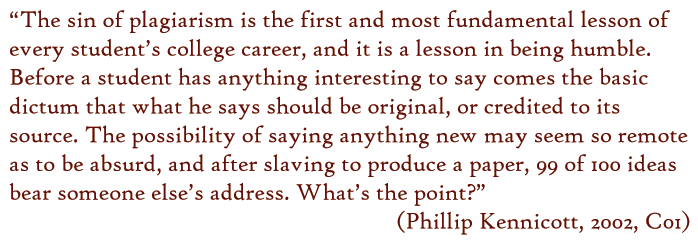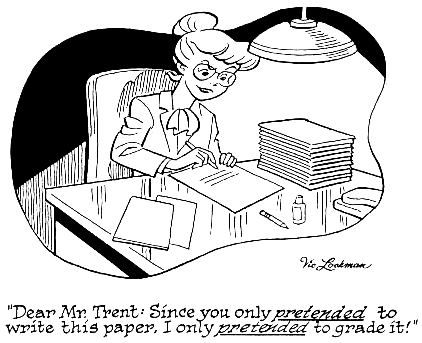Authorship and Anxiety

In the 1975 literacy crisis, lines were drawn and hierarchies established between standard English and vernacular English, “masters” of the English language who insisted on equal sway for every “fresh dialect” and “servants” willing to uphold the fixed rules that keep communication decipherable (Trimbur, 1991, p. 279-280). The Conference on College Composition and Communication’s (1974) adoption of the Students' Right to their Own Language resolution, Geneva Smitherman’s (1977) Talkin and Testifyin: The Language of Black America, and, later, Lisa Delpit’s (1988) “The Silenced Dialogue: Power and Pedagogy in Educating Other People’s Children” all form portions of the conversation regarding masters/servants and “appropriate” language during this crisis.
Echoes of the demarcations between masters and servants, honesty and dishonesty, are seen in today’s discussions of plagiarism. Many discussions of academic integrity establish false binaries that prioritize instructors who act as gatekeepers in the academy, spending tireless hours tracking down instances of cheating. The instructor finally unearths the plagiarism and ”shows” the student through a failing grade; the instructor is thus depicted as upholding what is just, right, and moral, much like the language of the iParadigms suite of technologies that describe admitting the ”right” applicants or upholding ”proper” scholarship (”WriteCheck for Students,” 2012). The plagiarism detection service is seen as a technology with the ability not only to assess textual material, but the individual producing that textual material as well; its role is to police and thereby produce docile, moral bodies: those who are right and proper. The story of ”Colonel Cheatbuster,” a testimonial linked on Turnitin.com, aptly illustrates this mentality:
It is not an indication of poor teaching to detect and report instances of academic dishonesty. It is, in fact, the opposite. If you let these instances go, you are contributing to the problem. ... Academic dishonesty is an insidious problem that, in many instances, can be seen as a symptom of our society’s anti-intellectualism and the attendant and common attitude that academic requirements are “elitist.”… I write this to all of you as a foot soldier in the war on academic dishonesty who has risen in the ranks, with battlefield commissions, to officer status. Just call me “Colonel Cheatbuster.” (Stanlick, 2008, p. 2)
Militaristic metaphors such as these evoke an us-versus-them mentality and portrays students as those to be fought against rather than co-learners in the classroom.
Following these battlefield metaphors, students are often depicted as willfully attempting to plagiarize, hoping their instructors will lack the time or technological ability to ascertain their dishonesty. Stereotypical tropes include the rebellious student who hopes to pull one over on his teacher or the technologically savvy student and his clueless instructor. As one testimonial on Turnitin.com notes, ”We've gone from a very computer-savvy group of kids who were getting away with plagiarism for years, to having it cut out of the picture completely” (”Turnitin: Success: Miami Palmetto Senior High School,” 2012). The cartoon below  epitomizes the clash between these two groups; the instructor, with an almost self-satisfied smirk on her face, pens a note to her student: ”Dear Mr. Trent: Since you only pretended to write this paper, I only pretended to grade it!” As a gatekeeper of correctness in the university, she shows up her student who tried to cheat—and failed.
epitomizes the clash between these two groups; the instructor, with an almost self-satisfied smirk on her face, pens a note to her student: ”Dear Mr. Trent: Since you only pretended to write this paper, I only pretended to grade it!” As a gatekeeper of correctness in the university, she shows up her student who tried to cheat—and failed.
The inverse of this binary depicts students who, as Phillip Kennicott (2002) noted, rail at the falsity of finding something wholly original to say in response to trite assignments doled out by instructors who recycle the same materials year after year; sometimes, the students struggle to find something original to say as they move from novitiates in their field to researchers inventing the university (Bartholomae, 1985). When classes subscribe to a banking model of education as outlined by Paulo Freire (1970), where memorization and regurgitation of concepts is sufficient evidence of learning, knowledge is thereby constructed as arhetorical units of information to be disseminated on command. It is no wonder that a student in a class who is asked to write a fifteen-page paper on any subject covered so far in the course would be stymied as to how to complete such a task. Given that research has shown how students are challenged when writing in a field that is new to them or when working within an unfamiliar rhetorical situation, it seems unsurprising that unintentional plagiarism such as patchwriting may occur; additionally, as Howard (1993) has noted, such patchwriting can serve as a valuable step in the student's learning process when confronted with new or difficult material. Yet these false binaries of teacher versus student, gatekeeper versus rebel, rely on our remaining congruent with simplistic definitions of plagiarism rather than breaking them down and complicating them.
Many plagiarism detection services play into these false binaries through the testimonials invoked on their websites, the glowing photos of actual instructors who use the services, the before-and-after narratives that form a large portion of the sales pitch. These messages conflict with the underlying ideologies of judgment and assessment rather than pedagogy (Purdy, 2009, p. 68). The overt message of helping students become better writers and improving the relationship between students and faculty is undermined by the evaluative role that forms the heart of the iParadigms universe—the determination of authorial integrity through individual, original authorship, even if the student is a novice to the field. Turnitin's OriginalityCheck service demarcates writing as original or unoriginal, stating a percentage of unoriginal work and linking back to the source. A numerical assessment of originality in this way reinforces black-and-white views of authorship that do not accurately represent twenty-first century composing practices, which include wiki writing, remixes, mashups, and other hybrid forms of authorship.
index ![]()
![]() the specter of internet plagiarism
the specter of internet plagiarism ![]()
![]() the turn to turnitin.com page 1
the turn to turnitin.com page 1 ![]() page 2
page 2 ![]() page 3
page 3 ![]() page 4
page 4 ![]() page 5
page 5 ![]() page 6
page 6 ![]()
![]() authorship and anxiety page 1
authorship and anxiety page 1 ![]() page 2
page 2 ![]() page 3
page 3 ![]() page 4
page 4 ![]() page 5
page 5 ![]() page 6
page 6 ![]()
![]() critical assessment
critical assessment ![]()
![]() references
references

